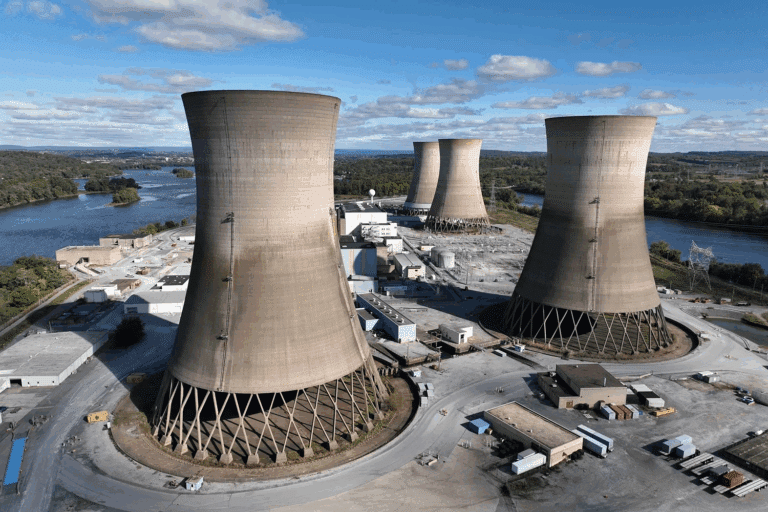This website uses cookies as well as similar tools and technologies to understand visitors’ experiences. By continuing to use this website, you consent to Columbia University’s usage of cookies and similar technologies, in accordance with the Columbia University Website Cookie Notice.
Energy Explained
Insights from the Center on Global Energy Policy
Why the Labour Government’s Pathbreaking New Clean Energy Company Could Be A Bellwether for the Energy Transition

This Energy Explained post represents the research and views of the author. It does not necessarily represent the views of the Center on Global Energy Policy. The piece may be subject to further revision. Contributions to SIPA for the benefit of CGEP are general use gifts, which gives the Center discretion in how it allocates these funds. Rare cases of sponsored projects are clearly indicated.
For a full list of financial supporters of the Center on Global Energy Policy at Columbia University SIPA, please visit our website at Our Partners. See below a list of members that are currently in CGEP’s Visionary Circle. This list is updated periodically.
Following a landslide win, the Labour Party under the leadership of Sir Keir Starmer has returned to power in the United Kingdom after fourteen years. While much of their campaign platform reflects “New Labour” principles,[1] there is one initiative that echoes—at first glance– earlier Labour policies from the post-war nationalization era that birthed British Steel, the National Coal Board, and British Gas. The Starmer-led foray into state-owned enterprises involves the proposed creation of Great British Energy (GB Energy), to be sure with a more limited scope than earlier government interventions but still a notable return of the government to a direct ownership role in the UK energy sector.
The GB Energy model seeks to unlock rather than crowd out private capital investment in decarbonization technologies and clean energy projects like offshore wind and hydrogen. Creating a state-owned, equity investment company like GB Energy will likely represent the next evolution of the current OECD “green industrial policy” boom. To date, green industrial policy has relied on regulation, subsidies, R&D, and trade protectionism, creating a complex and frequently inefficient toolkit for businesses to navigate.[2] GB Energy offers a more direct approach of co-investment, creating both more risk and potential upside for taxpayers.
Back to the Future: SOEs, Energy Security, and Industrial Policy
GB Energy will be a state-owned clean energy company, according to the Labour platform, capitalized with an initial £8.3 billion investment– with 3.3 billion for local energy project grants and 5 billion of capital to take ownership stakes in energy companies and projects.[3] Unlike the state-owned enterprises of the past, GB Energy will not pursue nationalizations and will be far from a monopoly, but it will be targeting both the UK’s green industrial might and its decarbonization agenda.[4] Its proponents see the company as more of an EDF or Orsted than a British Steel nationalized monopoly , complementing private sector investment rather than displacing it.[5]
This mission is analogous to the national crisis-based industrial policy missions faced by the UK in the past, from the post-World War II recovery to the energy and inflation shocks of the 1970s. Those analogies particularly hold if you believe, like many Labour voters and newly elected MPs, that “climate change is the greatest challenge we face” and a wartime, whole-government effort is the only path forward on climate action.[6]
While green industrial policy may be relatively new in the UK and other OECD countries, industrial policy itself is not. The above-mentioned cases of past Labour government industrial nationalizations in the UK represent the either the pinnacle or nadir, depending on one’s perspective, of industrial policy — monopoly government ownership of key industries. National oil companies like Norway’s Statoil/Equinor were created to foster a state-owned national champion in the oil/gas sector but left room for other companies to develop resources in Norwegian territory. OECD governments also created state-owned enterprises to lead development in sectors like nuclear reactors and fuel (Areva in France and Cameco in Canada) or public power (TVA and Bonneville Power Authority in the United States).
The industrial policy toolkit in the OECD has, over the past couple of decades, witnessed a cycle of privatizations of state-owned enterprises,[7] and the development of a toolkit of other industrial policy tools.[8] These include a wide range of subsidies from tax credits to R&D grants to export finance to using government procurement to bolster demand for new products. Trade policy has also played a critical role, as governments are frequently tempted to ensure that subsidies benefit domestic industry and workers, creating a swath of “Buy America”-type provisions, and not just in the USA.[9] Governments have also used the public sector balance sheet to underwrite loans for strategic industries, sometimes at market rates but often at concessionary terms.
How will GB Energy be Different?
The most recent US cycle of mega-industrial policy focused on green industries (through the Inflation Reduction Act) and the semiconductor industry (CHIPs Act) features all of the above and more. The UK, Canada, EU, and other jurisdictions have in turn responded with their own green industrial policy programs.
Absent, however, is the direct equity investment by government entities in decarbonization-focused companies and projects. This is the void that GB Energy will fill in UK climate and green industrial policy. Government equity investment is seen by some as a slippery slope to nationalization. Other critics would argue that a government stake means an enterprise will drift from focus on profitability to other more political objectives – indeed GB Energy’s focus on regional economic development is raising such accusations. And many politicians will fear that the inevitable “losers” in an equity-driven strategy will become an electoral liability.
By being limited to the UK energy sector, there are also portfolio concentration risks, although Labour leaders say GB Energy could go global “eventually.” [10] Relative to equity investments, government loan guarantees and debt-based investments with strong recourse for clean energy projects are perceived as mitigating some but not all of these risks.
GB Energy will focus on providing equity capital but seemingly in partnership with the private sector. As such it will not likely be an operator like the British Gas or British Steel of old. This will help pre-revenue decarbonization-focused companies particularly if the cost of capital comes down below the premium venture capital rates demanded by most early-stage investors. GB Energy is also expected to help energy infrastructure developers with attractive cost of capital because there will be no dividend payment back to government, just recovery of initial investment.[11] Taxpayers could benefit from a portfolio of government equity investments as well. Government equity-based bailouts of the airlines and auto industries in the US and Canada after the 2008 financial crisis generated a good return for taxpayers — another case of “maximum” government industrial policy being applied under crisis conditions.[12]
Is equity-based public sector investment the next frontier for green industrial policy?
Other OECD countries are dabbling with this equity capital-based approach to green industrial policy. In Canada, the Canada Growth Fund (CGF) was created in 2022 with a $15 billion mandate to invest in clean energy projects, not just through direct equity investment[13] but through making investments in privately held clean energy funds. Unlike GB Energy, CGF also has the ability to take equity risk with taxpayer dollars but relies on an independent Public Service Pension fund manager to deploy capital.[14]
The type of equity investments embedded in government-owned facilities like GB Energy and CGF are dwarfed by the trillions of dollars of private capital in the hands of asset managers. Yet those trillions of dollars have failed to yield the deployment of low and zero-carbon energy technology in a number of critical sectors, from clean fuels for heavy transportation to direct air carbon capture to small modular nuclear reactors.[15]
Government loan guarantees and tax credits augment private investment but the co-investment of government capital for equity could open another important channel – one in which taxpayers, industry, and investors share the same upside and downside. This could reduce or mitigate arguments around corporate welfare and even bolster voter support for climate action if direct returns—versus hard-to-measure, indirect returns on job creation, technology deployment, and GHG reductions—are the benchmark. Of course, equity funds will lose money at times but under current models, taxpayers rarely recover investments like grants or subsidized loans when things go wrong either.
In the context of the trillions of dollars needed to tackle climate change, it seems wise to expand the scope of financial or policy tools on the table. GB Energy may prove an excellent case study to watch to determine whether government equity capital can be part of the climate solution.
CGEP’s Visionary Circle
Corporate Partnerships
Occidental Petroleum Corporation
Tellurian Inc
Foundations and Individual Donors
Anonymous
Anonymous
the bedari collective
Jay Bernstein
Breakthrough Energy LLC
Children’s Investment Fund Foundation (CIFF)
Arjun Murti
Ray Rothrock
Kimberly and Scott Sheffield
[1] https://foreignpolicy.com/2024/07/03/starmer-labour-blair-election-britain-tories-optimism/
[2] https://www.ft.com/content/a1a99a43-eca1-42ac-942b-30351daba248
[3] https://www.politico.eu/article/labour-party-energy-company-uk-election-keir-starmer/
[4] https://www.theguardian.com/politics/article/2024/jun/06/could-labour-gb-energy-plan-future-proof-power-generation-uk
[5] Orsted is 50.1% owned by the Danish government and EDF was fully re-acquired by the French government in 2023.
[6] https://labour.org.uk/change/make-britain-a-clean-energy-superpower/
[7] OECD (2019), A Policy Maker’s Guide to Privatisation, Corporate Governance, OECD Publishing, Paris, https://doi.org/10.1787/ea4eff68-en.
[8] https://itif.org/publications/2021/10/04/emerging-industrial-policy-approaches-united-states/
[9] https://www.wilsoncenter.org/article/protectionism-back-not-you-know-it-how-us-inflation-reduction-act-reshaping-path-green
[10] https://www.politico.eu/article/labour-party-energy-company-uk-election-keir-starmer/
[11] https://www.common-wealth.org/publications/the-greatest-generation-how-public-power-can-deliver-net-zero-faster-fairer-and-cheaper
[12] https://www.nytimes.com/2014/12/20/business/us-signals-end-of-bailouts-of-automakers-and-wall-street.html#:~:text=Although%20the%20overall%20bailout%20efforts,of%20the%20%2449.5%20billion%20invested.
[13] https://www.cgf-fcc.ca/content/documents/CGF_News_Release.pdf
[14] https://www.cgf-fcc.ca/content/documents/CGF_Press_Release_Idealist_Capital.pdf
[15] https://www.irena.org/News/pressreleases/2023/Mar/Investment-Needs-of-USD-35-trillion-by-2030-for-Successful-Energy-Transition
More on Energy Explained Energy Explained
The Social Cost of Carbon Is Gone — and That May Be Good News for Future US Climate Policy
President Trump has ended the federal government’s use of the "social cost of carbon" (SCC), an official estimate of the harms caused by carbon dioxide emissions.

Expert Voices in Energy: The Promise and Peril of Foreign Entity Restrictions
In July, Republicans in Congress passed their signature domestic policy package, the One Big Beautiful Bill Act (or, H.R. 1).

Assessing the Energy Impacts of the One Big Beautiful Bill Act
This special CGEP blog series, featuring six contributions from CGEP scholars, analyzes the potential impacts of the OBBBA across a range of sectors.

Q&A: An Energy Take on the Current State of the Iran-Israel-US Conflict
The conflict between Iran, Israel, and now the United States has yet to disrupt energy supplies to global markets.

Relevant
Publications

Trump’s One Big Beautiful Bill Act Has Given the US Hydrogen Industry Certainty — but Where Will the Green Energy Come From?
H2 projects will have to compete for a shrinking pipeline of zero-carbon electricity with energy-intensive data centres.

The United States Needs a Nuclear Operation Warp Speed
A nuclear energy resurgence is vital to meet rising electricity demand.



